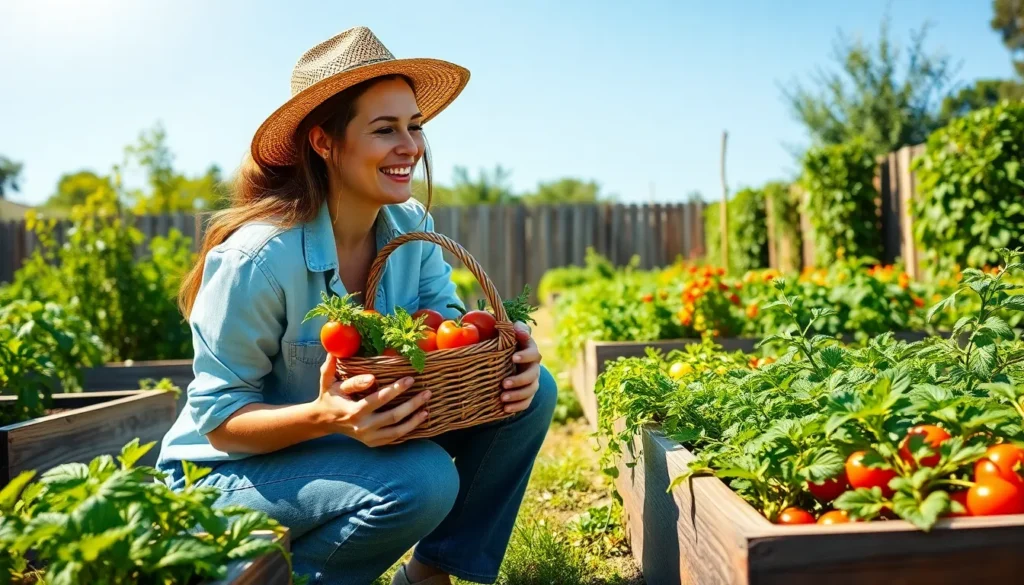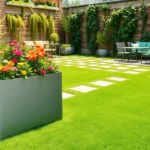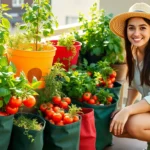Growing your own vegetables transforms your backyard into a productive paradise that feeds both your family and your soul. We’ve discovered that even the smallest spaces can yield impressive harvests when you choose the right approach and plants for your unique situation.
Whether you’re working with a sprawling yard or a compact corner, vegetable gardening offers endless possibilities that’ll save you money while providing fresh, nutritious produce right outside your door. From raised beds to vertical gardens, container growing to traditional in-ground plots, there’s a perfect solution waiting for your space.
We’ll share proven strategies that maximize your growing potential while minimizing common beginner mistakes. These practical ideas will help you create a thriving vegetable garden that produces abundant crops season after season, regardless of your experience level or yard size.
Choose The Perfect Location For Your Backyard Vegetable Garden
Location determines whether your backyard vegetable garden thrives or struggles throughout the growing season. We’ll help you identify the ideal spot by evaluating three critical factors that directly impact plant health and harvest yields.
Assess Sunlight Requirements And Patterns
Sunlight exposure serves as the foundation for successful vegetable production in any backyard garden. Most vegetables require 6 to 8 hours of direct sunlight daily to develop properly and produce abundant harvests. We recommend observing your yard throughout different times of day to map sun patterns across potential garden locations.
Track shadows cast by buildings, fences, and large trees during morning, midday, and afternoon hours. These observations reveal which areas receive full sun versus partial shade conditions. Tomatoes, peppers, and squash demand full sun exposure, while leafy greens like lettuce and spinach tolerate partial shade areas.
Document seasonal changes in sunlight patterns since tree canopies and sun angles shift throughout the year. Spring gardens may receive adequate light that becomes blocked once trees leaf out in summer. We suggest taking photos of your yard during different seasons to reference when planning future garden expansions.
Evaluate Soil Drainage And Quality
Soil drainage prevents root rot and other moisture related problems that destroy vegetable plants. Well draining soil allows excess water to move through while retaining enough moisture for plant roots. We test drainage by digging a hole 12 inches deep and filling it with water to see how quickly it drains.
Quality soil contains organic matter, proper pH levels, and essential nutrients that vegetables need to grow. Most vegetables thrive in slightly acidic to neutral soil with pH levels between 6.0 and 7.0. We recommend conducting a soil test through your local extension office to determine pH levels and nutrient content.
Compacted soil restricts root growth and water penetration, creating challenging growing conditions. Heavy clay soils often drain poorly and become waterlogged, while sandy soils drain too quickly and require frequent watering. We improve soil quality by adding compost, aged manure, or other organic amendments to create the ideal growing medium.
Consider Proximity To Water Sources
Water accessibility simplifies daily garden maintenance and ensures consistent plant hydration. Locating your vegetable garden within 100 feet of a water source reduces the effort required for regular watering tasks. We prioritize garden locations near outdoor spigots, rain barrels, or irrigation systems to streamline care routines.
Consistent watering schedules support healthy plant development and prevent stress related issues. Vegetables require different amounts of water depending on their growth stage, weather conditions, and soil type. We install drip irrigation systems or soaker hoses in gardens located far from water sources to maintain steady moisture levels.
Emergency watering situations arise during heat waves, droughts, or when automatic systems fail. Having backup water access prevents crop loss during critical growing periods. We keep watering cans, hoses, or portable containers nearby to address immediate plant needs when primary water sources become unavailable.
Design Your Garden Layout For Maximum Productivity
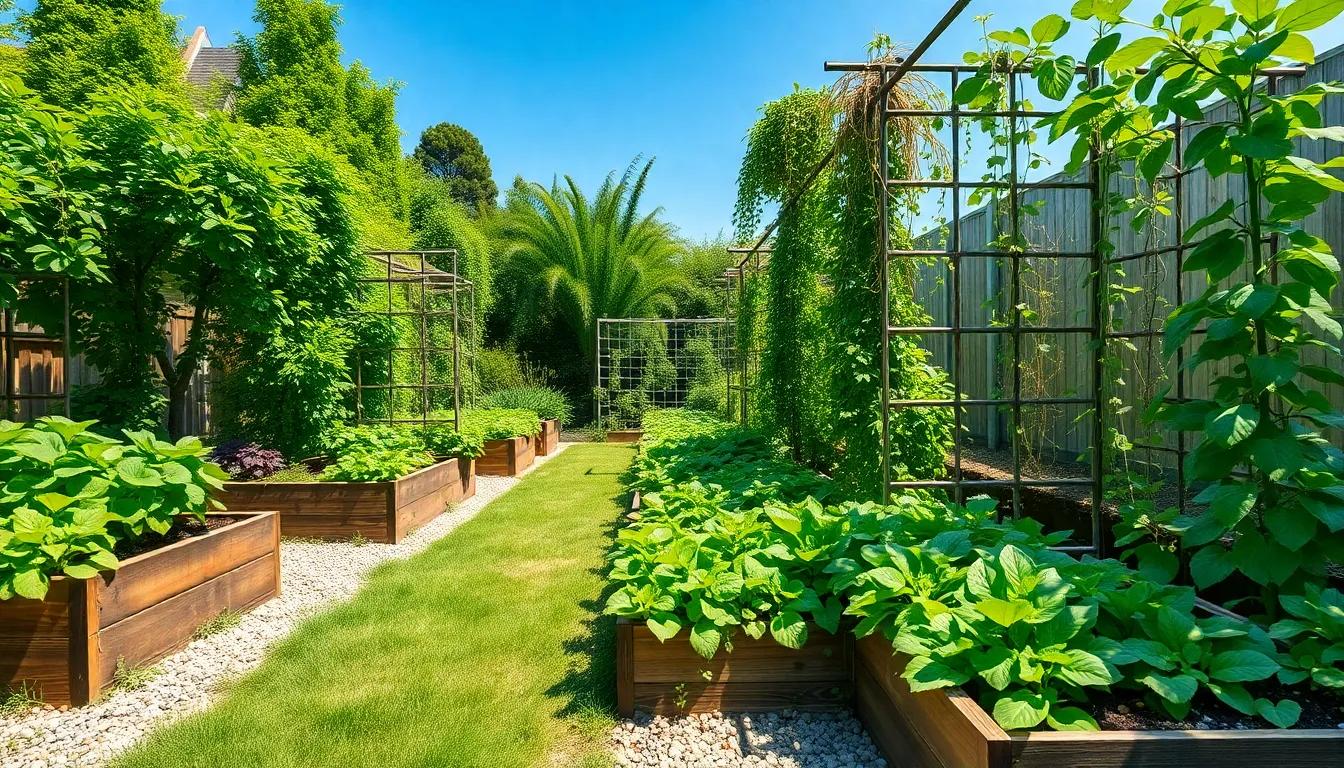
Smart garden design transforms your backyard space into a highly efficient growing system. We’ll explore three essential layout strategies that maximize both productivity and accessibility.
Plan Raised Beds For Better Soil Control
Raised beds give us complete control over our growing environment and dramatically improve crop health through better drainage. We can customize soil composition for different vegetables while preventing issues like waterlogged roots that plague ground level plantings.
Tall raised beds work exceptionally well for root vegetables like carrots, parsnips, and potatoes since they provide deeper soil depth for proper development. We recommend building beds at least 12 inches deep for most vegetables, though root crops benefit from 18 to 24 inches of soil depth.
Square foot gardening offers an incredibly efficient approach using four by four foot raised beds divided into one foot squares. This method allows us to plant different vegetables in each square while maximizing our harvest per square foot of garden space.
Create Pathways For Easy Access And Maintenance
Pathways structure our garden layout while preventing soil compaction that can damage plant roots and reduce yields. We suggest using gravel or mulch materials that provide stable footing and complement the overall garden aesthetic.
Gravel pathways between beds create a clean, professional appearance while significantly reducing weed growth compared to bare soil paths. Mulch pathways offer a more natural look and can be made from wood chips, straw, or shredded leaves that eventually decompose and enrich the soil.
Planning pathway width ensures comfortable access for maintenance tasks like weeding, harvesting, and watering. We recommend making main pathways at least 3 feet wide to accommodate wheelbarrows and garden carts.
Incorporate Vertical Growing Structures
Vertical elements maximize our growing space by utilizing the upward dimension of our garden layout. Arbors and trellises provide perfect support for climbing vegetables like peas, beans, and cucumbers while creating attractive focal points.
Wall mounted planters and pallet gardens excel for growing herbs and leafy greens, especially when horizontal space is limited. These vertical answers can transform blank walls or fences into productive growing areas.
Color coordination enhances visual appeal by arranging vegetables based on their leaf colors or future fruit colors throughout our vertical and horizontal spaces. This design approach creates an attractive potager garden that combines beauty with productivity.
Select The Best Vegetables For Your Climate Zone
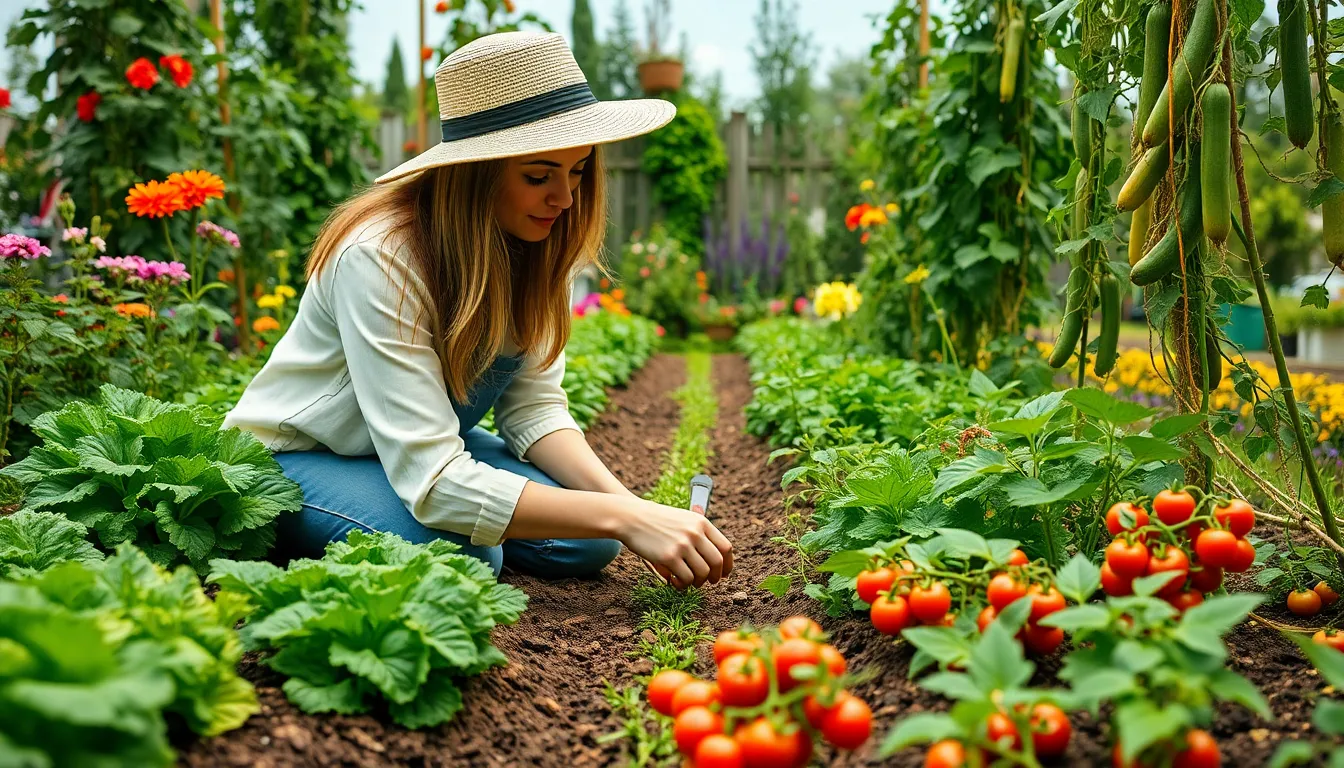
Climate zone selection forms the foundation of a thriving backyard vegetable garden. Understanding your exact growing conditions ensures we choose plants that’ll flourish rather than struggle in our local environment.
Research Your Local Growing Season
USDA Plant Hardiness Zones guide us toward vegetables that thrive in our exact climate conditions. We’ll discover which plants naturally adapt to our area’s temperature ranges and seasonal patterns by consulting this essential resource.
Cool season crops like lettuce, spinach, and peas grow exceptionally well during spring and fall months. These vegetables prefer moderate temperatures and can tolerate light frosts that would damage heat-loving plants.
Warm season crops such as tomatoes, peppers, and cucumbers require summer heat to reach their full potential. We must wait until soil temperatures consistently stay above 60°F before planting these heat-dependent varieties.
Frost dates determine our planting schedule and help us avoid costly mistakes. Local extension services provide accurate frost predictions exact to our microclimate, while seed packets offer detailed timing recommendations for optimal results.
Choose High-Yield Varieties For Small Spaces
High-yield varieties maximize our harvest potential within limited backyard spaces. Bush beans produce abundant crops in compact areas, making them perfect for raised beds or container gardens.
Cherry tomatoes deliver continuous harvests throughout the growing season while requiring minimal ground space. These prolific plants often yield more fruit per square foot than their full-sized counterparts.
Leafy greens including lettuce and kale provide multiple harvests from single plantings. We can harvest outer leaves while allowing centers to continue growing, extending our fresh salad supply for weeks.
Compact peppers fit perfectly within tight garden layouts while producing substantial yields. These space-efficient varieties allow us to grow multiple pepper plants where traditional varieties would crowd out other crops.
Vertical gardening with vining crops like pole beans or trellised cucumbers saves valuable ground space. We can train these climbing plants upward using supports, freeing horizontal space for additional plantings.
Plan For Succession Planting
Succession planting ensures continuous harvests throughout our growing season. Quick-maturing crops like radish and arugula can occupy the same space multiple times per season, maximizing our garden’s productivity.
Garden planners help us track planting dates, crop rotation schedules, and bed assignments systematically. These organizational tools maintain soil health while reducing pest and disease problems that plague unplanned gardens.
Heat-tolerant greens follow early spring crops as temperatures rise during summer months. We can transition from cool season lettuce to warm season alternatives like Swiss chard or amaranth greens.
Fall crops extend our harvest season well into autumn when properly timed. Late summer plantings of spinach, kale, and radishes provide fresh vegetables after summer crops finish producing.
High-value crops including tomatoes, peppers, onions, and garlic deserve priority placement in our succession plans. These expensive grocery store items offer the greatest return on our gardening investment and space allocation.
Prepare Your Soil For Optimal Plant Growth
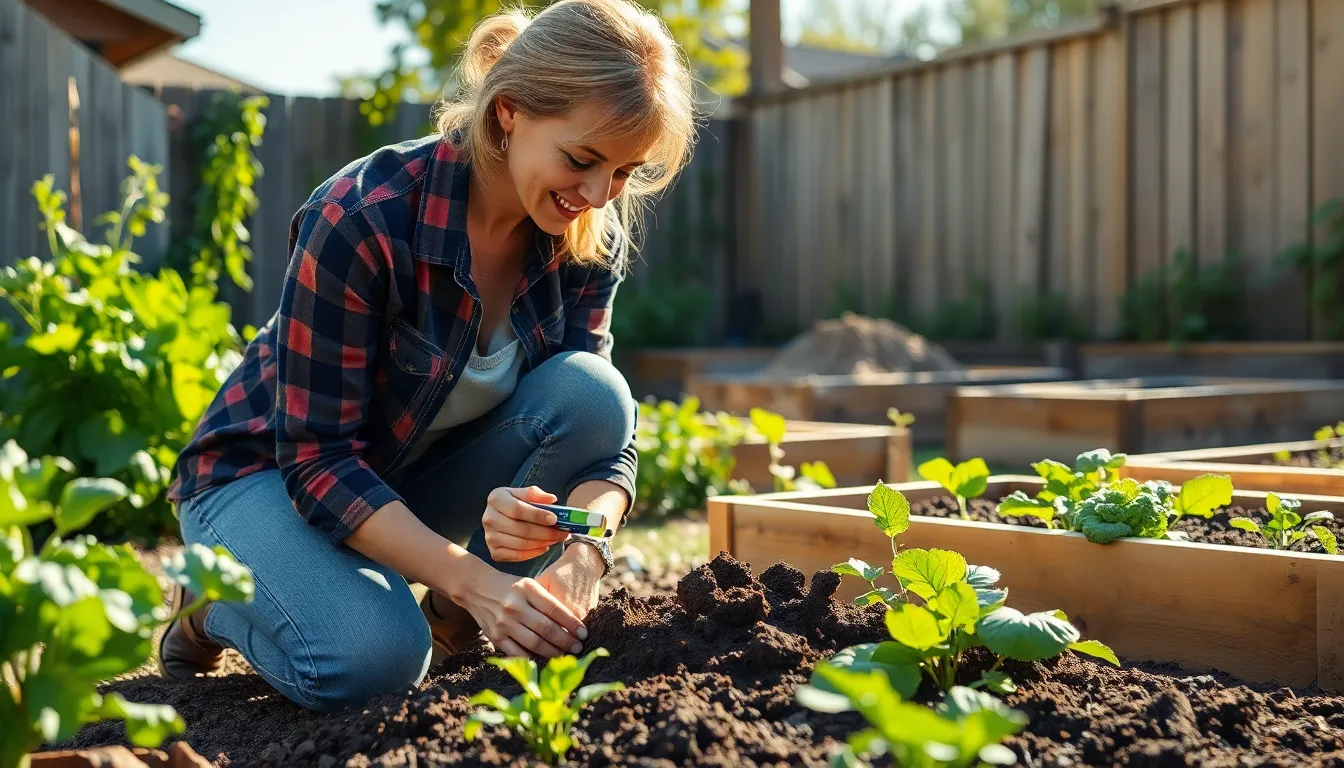
We’ll create the foundation for a thriving vegetable garden by focusing on three essential soil preparation steps. Proper soil conditions directly impact plant health and harvest yields.
Test Soil pH And Nutrient Levels
Testing your soil reveals the exact conditions your vegetables will face throughout the growing season. Most vegetables thrive in slightly acidic to neutral soil with a pH range between 6.0 and 7.0. You can purchase affordable soil testing kits at garden centers or send samples to your local agricultural extension office for comprehensive analysis.
Nutrient testing shows which elements your soil lacks for optimal plant growth. Common deficiencies include nitrogen for leafy growth, phosphorus for root development, and potassium for fruit production. We recommend testing in early spring before planting to allow time for necessary amendments.
Document your test results to track improvements over time. This information helps you make informed decisions about fertilizers and soil amendments for future growing seasons.
Add Organic Compost And Amendments
Organic compost transforms poor soil into a nutrient rich growing medium that supports healthy plant development. We suggest adding 2 to 4 inches of well aged compost to your garden beds each season. Quality compost improves soil structure, increases water retention, and provides slow release nutrients throughout the growing period.
Exact amendments target particular soil issues based on your test results. Clay soils benefit from coarse sand and perlite to improve drainage, while sandy soils need organic matter like aged manure or leaf mold to retain moisture. Lime raises pH in acidic soils, whereas sulfur lowers pH in alkaline conditions.
Mix amendments thoroughly into the existing soil to create uniform growing conditions. We recommend working amendments 8 to 12 inches deep to match the root zone of most vegetables.
Create Proper Soil Depth For Root Development
Root systems require adequate space to access nutrients and water for optimal plant growth. Most vegetables need 12 to 18 inches of loose, well prepared soil to develop healthy root structures. Shallow soil restricts root expansion and limits plant productivity.
Raised beds offer excellent control over soil depth and composition for vegetable gardening. We suggest building beds 8 to 12 inches high and filling them with quality garden soil mixed with compost. This approach ensures consistent growing conditions across your entire garden space.
Double digging creates deep, loose soil in traditional ground level gardens. This technique involves removing the top layer of soil, loosening the subsoil, and replacing the topsoil with added organic matter. The process requires more effort but produces exceptional growing conditions for root vegetables like carrots and parsnips.
Implement Space-Saving Growing Techniques
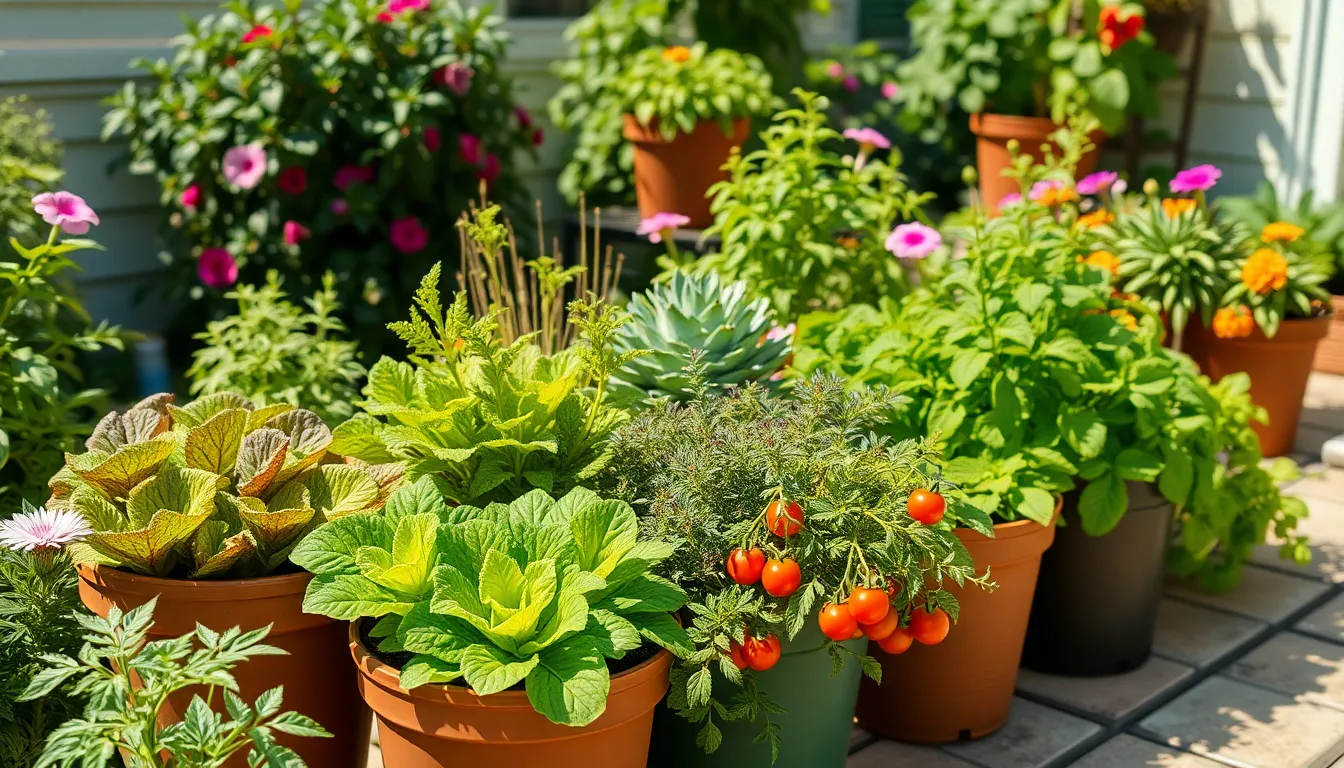
Transform your backyard vegetable garden into a productive oasis using smart growing techniques that maximize every inch of available space. These strategic approaches help us achieve higher yields while maintaining manageable garden sizes.
Use Container Gardening Methods
Container gardening offers complete control over soil conditions while making the most of limited space. We recommend using containers at least 6-8 inches deep to accommodate proper root growth for vegetables like lettuce, herbs, and cherry tomatoes. Deeper containers work better for root vegetables and larger plants.
Soil selection becomes critical when growing vegetables in containers. Use well-draining potting mix specifically designed for containers rather than garden soil, which compacts and restricts root development. This specialized mix ensures healthy plant growth and prevents waterlogged roots.
Strategic placement allows us to move containers throughout the season to follow optimal sunlight patterns. Position containers on patios, decks, or even balconies where traditional gardens won’t fit. Mobile container gardens adapt to changing weather conditions and space requirements.
Practice Companion Planting Strategies
Companion planting maximizes garden productivity by pairing vegetables that benefit each other naturally. Plant basil alongside tomatoes to enhance flavor and repel harmful insects, while marigolds near carrots help deter pests without chemicals. These strategic partnerships create healthier growing environments.
Intercropping techniques optimize space by combining fast-growing crops with slower-maturing plants. Radishes planted around pepper plants use space efficiently, as the radishes harvest before peppers need full growing room. This method increases overall yield per square foot.
Natural pest control emerges from thoughtful plant combinations that reduce the need for interventions. Aromatic herbs like rosemary and thyme planted near vulnerable vegetables create protective barriers against common garden pests. These companion relationships strengthen plant resilience naturally.
Maximize Harvest With Square Foot Gardening
Square foot gardening divides growing beds into manageable one-foot squares for intensive planting. This method allows us to plant densely while reducing weeding and watering needs significantly. Each square accommodates exact quantities of plants based on their mature size requirements.
Plant spacing optimization follows precise guidelines for maximum productivity within each square. Large plants like tomatoes occupy one plant per square, while smaller crops like radishes fit sixteen plants per square foot. This systematic approach eliminates guesswork and maximizes space utilization.
Succession planting within the square foot system ensures continuous harvests throughout the growing season. Plant fast-growing crops like lettuce and radishes every few weeks in designated squares to maintain steady production. This technique extends harvest periods and increases total yield from limited garden space.
Install Efficient Irrigation Systems
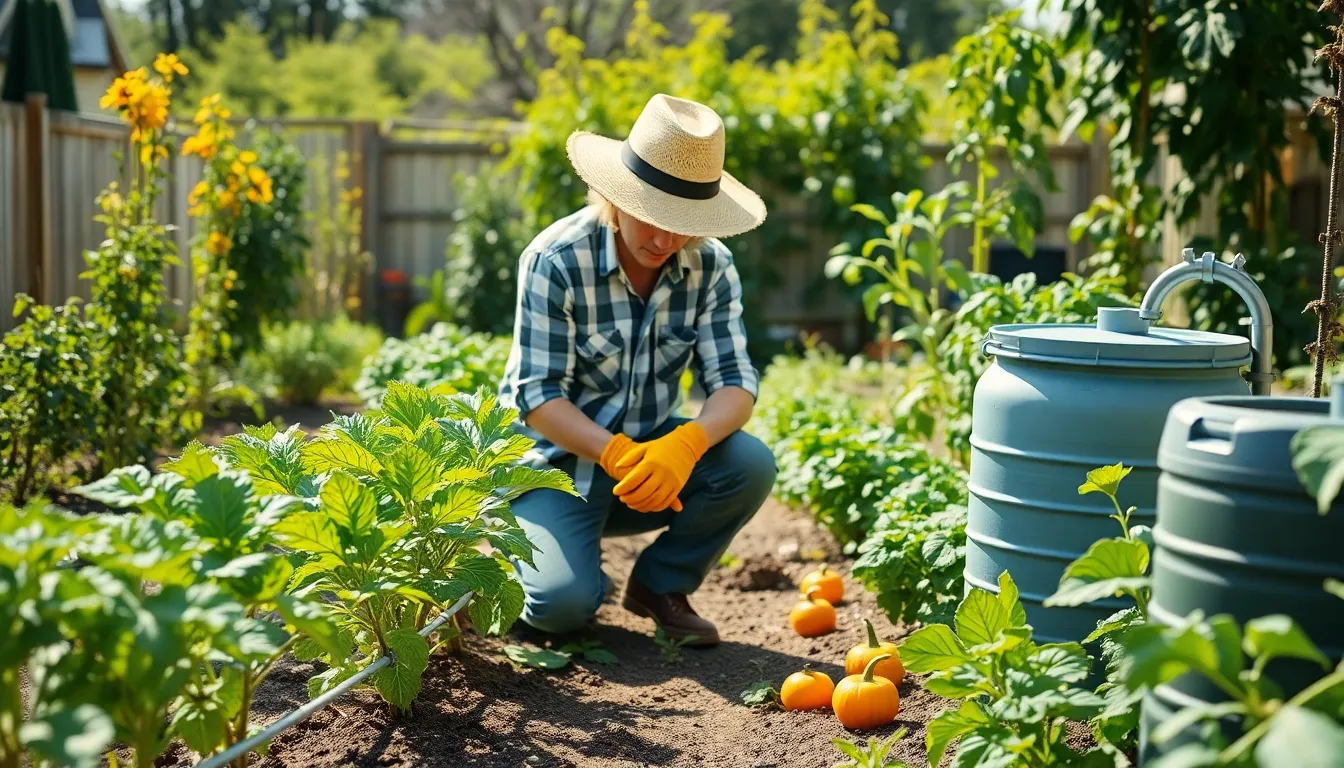
Successful vegetable gardening depends heavily on consistent water delivery that reaches plant roots without waste. Smart irrigation systems reduce maintenance time while ensuring our plants receive optimal hydration throughout the growing season.
Set Up Drip Irrigation For Water Conservation
Drip irrigation delivers water directly to plant roots, making it the most efficient watering method for backyard vegetable gardens. This system conserves water by eliminating runoff and evaporation that occurs with traditional sprinklers or hand watering. We can reduce our water usage by up to 50% compared to conventional irrigation methods.
Installing a drip system involves laying tubing along plant rows with small emitters positioned near each plant’s base. The slow, steady water release allows soil to absorb moisture gradually without creating puddles or washing away nutrients. Most vegetables thrive with drip irrigation because it maintains consistent soil moisture levels without wetting the foliage.
Timers automate the watering schedule, ensuring our plants receive water even when we’re away from home. We can adjust flow rates and timing based on plant needs, weather conditions, and seasonal changes. The initial investment pays for itself through reduced water bills and improved plant health.
Consider Soaker Hoses For Even Distribution
Soaker hoses distribute water evenly across garden beds through tiny pores along their length, reducing runoff while providing thorough soil saturation. These flexible hoses work well in raised beds and traditional garden rows where uniform moisture distribution is essential for consistent plant growth.
Installation requires simply laying the hoses along plant rows and connecting them to our main water source. We can weave them around plants or run them in straight lines between rows, depending on our garden layout. The porous material releases water slowly, allowing deep soil penetration that encourages strong root development.
Soaker hoses cost less than drip irrigation systems while providing similar water conservation benefits. We can cover larger areas quickly compared to individual drip emitters, making them ideal for gardens with uniform plant spacing. Connecting multiple hoses with splitters expands coverage across extensive garden areas.
Plan For Rainwater Collection
Rainwater collection systems reduce our dependence on municipal water supplies while lowering irrigation costs throughout the growing season. We can harvest free water that falls naturally on our property and store it for use during dry periods when our vegetables need consistent moisture.
Simple collection methods include placing barrels under downspouts or installing gutters on garden sheds to channel rainfall into storage containers. Rain collection reduces water bills while providing chemical free irrigation that many plants prefer over treated tap water. We should position collection barrels near our garden areas to minimize the distance water travels to reach our plants.
Storage capacity determines how much water we can save between rainfall events. A 1,000 square foot roof area generates approximately 600 gallons of water from one inch of rainfall, providing substantial irrigation reserves for most backyard gardens. We can connect multiple barrels with overflow pipes to increase storage volume and ensure we capture maximum rainfall throughout the season.
Create Natural Pest And Disease Management
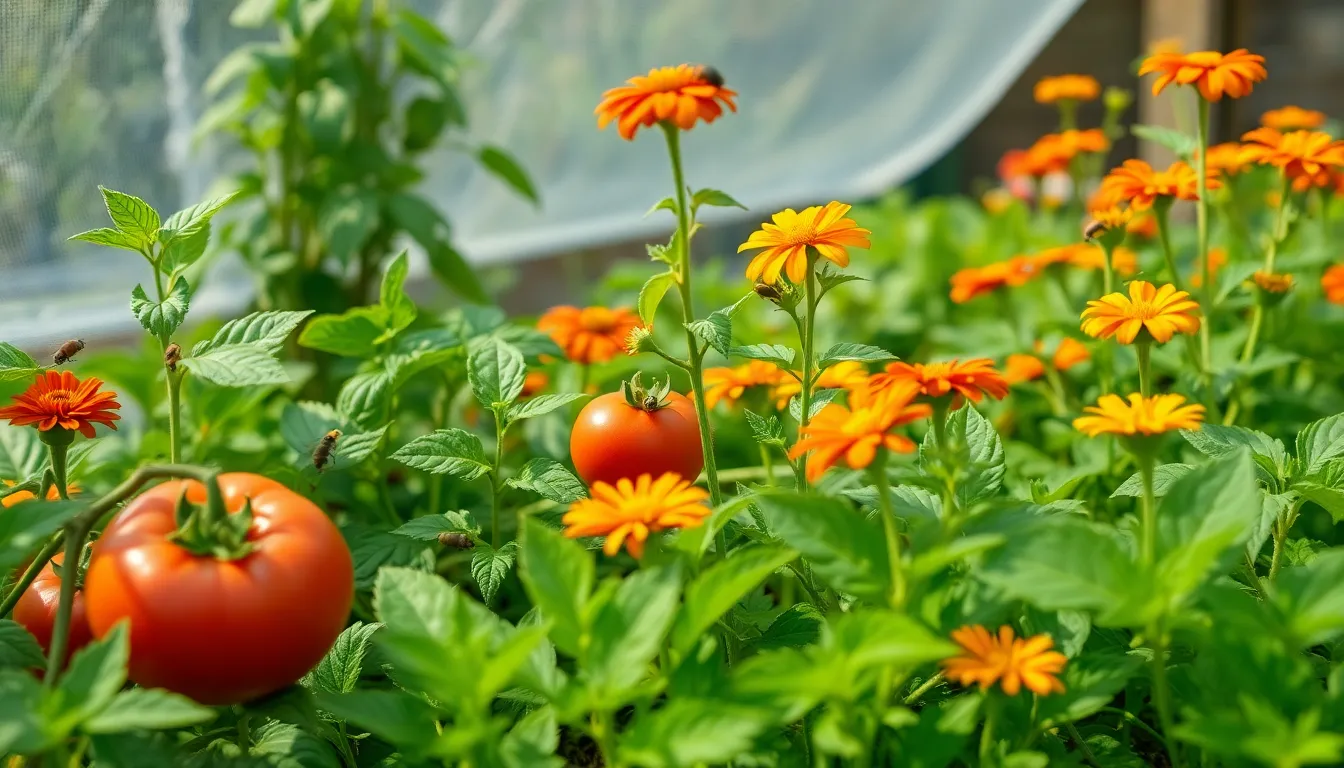
We can maintain healthy vegetable gardens without relying on harsh chemicals by implementing natural pest and disease management strategies. Effective approaches combine biological controls with sustainable practices that protect our plants while preserving beneficial garden ecosystems.
Attract Beneficial Insects With Companion Plants
Plant diversity creates a natural defense system that attracts beneficial insects like bees and ladybugs to control pests naturally. Marigolds planted alongside tomatoes release compounds that deter harmful insects while providing nectar for beneficial predators. Basil companion planted with vegetables not only enhances flavors but also repels aphids and spider mites.
Creating habitat for beneficial insects requires strategic plant selection throughout our garden spaces. We should incorporate flowering plants like nasturtiums and calendulas that bloom at different times to provide continuous food sources. Native wildflowers planted along garden borders establish permanent homes for beneficial insects that return year after year.
Build Physical Barriers And Row Covers
Row covers made from lightweight fabric protect plants from pests while allowing sunlight and water to reach crops effectively. We must ensure proper ventilation under covers to prevent heat buildup that can damage plants during warm weather. Fine mesh barriers installed around vulnerable crops like brassicas prevent cabbage moths and flea beetles from laying eggs on leaves.
Physical barriers offer immediate protection without chemicals or waiting periods before harvest. Copper strips placed around raised beds deter slugs and snails through natural electrical reactions. Garden fences constructed with hardware cloth prevent larger pests like rabbits and groundhogs from accessing our vegetable crops.
Carry out Organic Pest Control Methods
Hand picking pests during regular garden inspections removes problems before they multiply and spread throughout our crops. We should check plants weekly for signs of pest damage and manually remove larger insects like hornworms and beetle larvae. Soap answers created with mild dish soap and water effectively kill soft bodied pests like aphids and whiteflies on contact.
Dormant oil applications in late winter suffocate overwintering pests on woody plants before they become active in spring. Regular sanitation practices like removing plant debris and weeds eliminate pest overwintering sites and disease sources. Crop rotation implemented annually breaks pest life cycles and reduces disease buildup by planting tomatoes one year followed by beans or lettuce the next season.
Plan Your Planting Schedule For Continuous Harvest
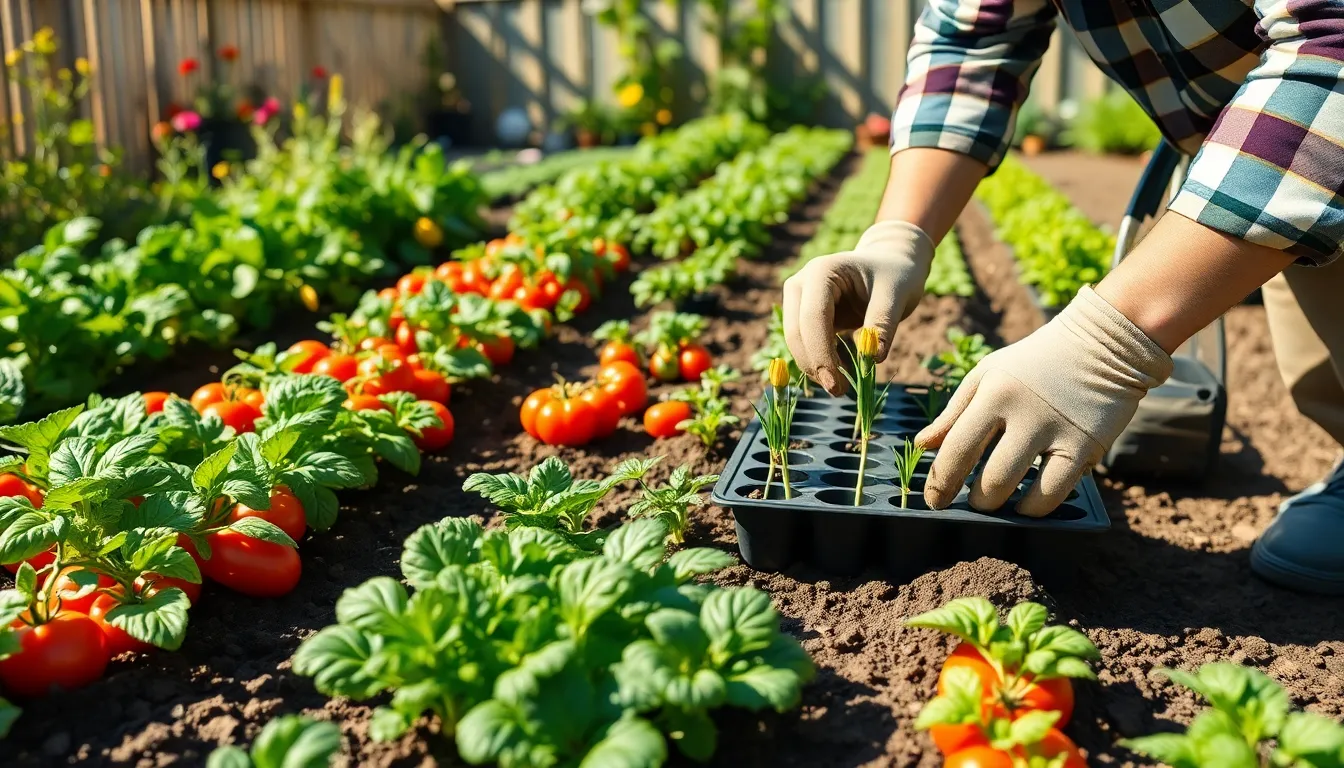
Strategic timing ensures our backyard gardens produce fresh vegetables from early spring through late fall. We’ll maximize our harvest potential by coordinating indoor seed starting, succession planting, and seasonal crop transitions.
Start Seeds Indoors For Extended Growing Season
Starting seeds indoors extends our growing season by 4-8 weeks before the last frost date. We gain valuable growing time by nurturing seedlings in controlled indoor environments while outdoor conditions remain too harsh for direct sowing.
Cool season crops like broccoli, lettuce, and spinach benefit from early indoor starts that allow transplanting as soon as soil becomes workable. Warm season varieties including tomatoes, peppers, and eggplants require indoor starting to develop strong root systems before outdoor temperatures stabilize.
We recommend using seed starting trays with proper drainage and quality potting mix to ensure healthy germination rates. Temperature control becomes critical during this phase, with most vegetable seeds germinating best between 65-75°F.
Timing calculations work backward from our last expected frost date to determine optimal seed starting schedules. We track these dates using garden calendars that account for weather changes and local frost patterns throughout the growing season.
Stagger Plantings For Ongoing Production
Staggered planting creates continuous harvests rather than overwhelming abundance followed by empty garden beds. We plant small batches of seeds or seedlings at regular intervals, typically every 1-2 weeks, to ensure steady production throughout the growing season.
Quick maturing crops like lettuce, radishes, and bush beans work exceptionally well for succession planting strategies. We can harvest these vegetables within 30-60 days of planting, allowing multiple plantings per season in the same garden space.
Planning intervals depends on each crop’s maturity timeline and our family’s consumption needs. We plant enough for immediate use while scheduling the next planting to mature as current crops finish producing.
Garden space allocation requires careful consideration when implementing staggered plantings. We reserve exact beds or rows for succession crops, rotating locations to prevent soil depletion and pest buildup between plantings.
Plan Cool Season And Warm Season Crops
Cool season vegetables thrive in temperatures between 50-70°F and tolerate light frosts that would damage warm season plants. We plant these crops including carrots, peas, and kale during early spring and late summer periods when temperatures favor their growth patterns.
Early spring plantings begin 2-4 weeks before the last frost date when soil temperatures reach 40-50°F. We schedule fall plantings 10-12 weeks before the first expected frost to allow crops to mature before winter conditions arrive.
Warm season crops require soil temperatures above 60°F and air temperatures consistently above 50°F at night. We plant tomatoes, cucumbers, and squash after all frost danger passes and soil has warmed sufficiently for proper root development.
Transition planning between seasons maximizes our garden productivity by utilizing the same space for different crops. We remove cool season plants as they finish producing and immediately prepare beds for warm season transplants or direct seeding.
Temperature monitoring helps us make informed planting decisions based on actual conditions rather than calendar dates alone. We use soil thermometers to verify planting readiness and track weather forecasts to protect vulnerable seedlings from unexpected temperature drops.
Design Maintenance-Friendly Garden Features
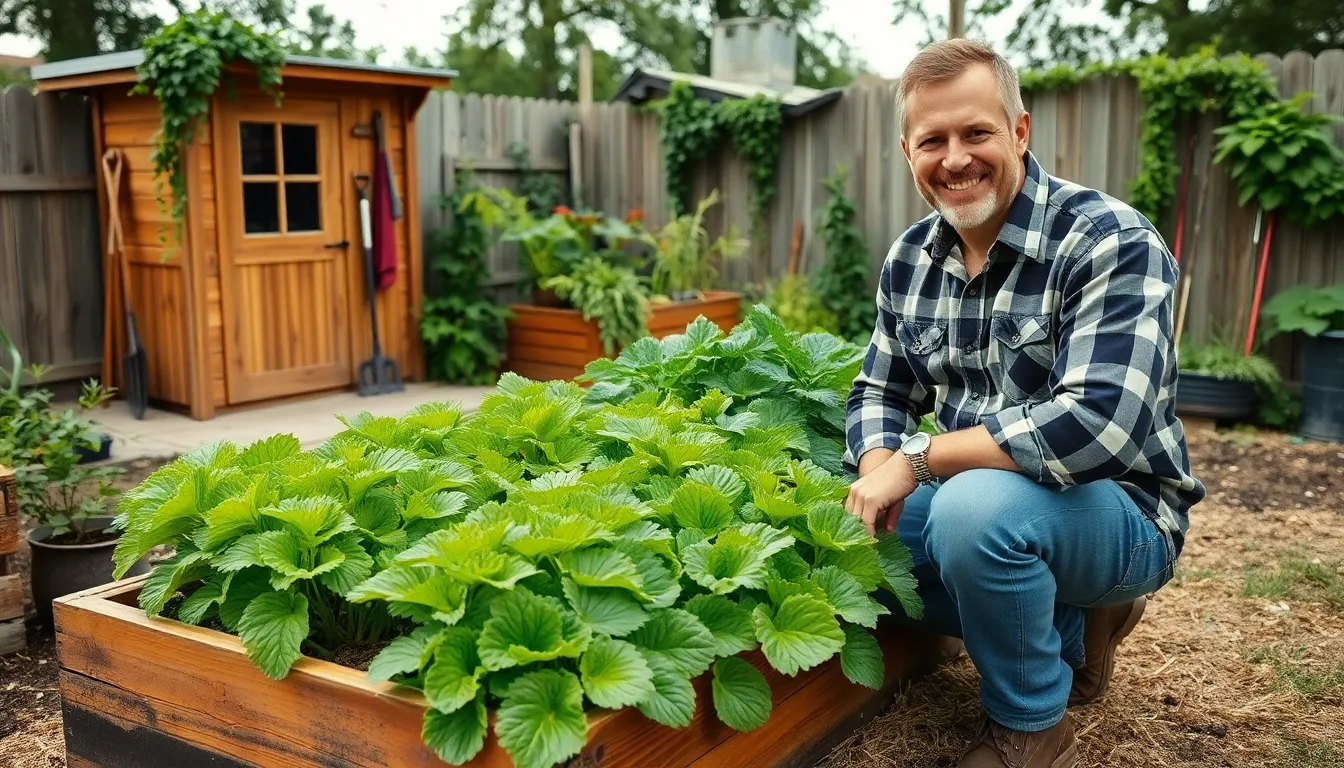
Smart garden design reduces our workload while maximizing vegetable production. These maintenance-friendly features streamline daily gardening tasks and create sustainable growing systems.
Install Mulching Systems For Weed Control
Organic mulch materials like wood chips and straw provide the most effective weed suppression while enriching soil as they decompose. We recommend applying a 2 to 3 inch layer around plants, maintaining several inches of clearance from plant stems to prevent moisture-related diseases.
Wood chips work exceptionally well for perennial vegetable areas and pathways, lasting up to two seasons before requiring replacement. Straw mulch performs better around annual vegetables like tomatoes and peppers, as it breaks down faster and integrates easily into seasonal soil preparation.
Application timing matters significantly for maximum effectiveness. We apply mulch after soil temperatures warm in spring and plants establish their root systems, typically 2 to 3 weeks after transplanting seedlings outdoors.
Create Tool Storage Answers
Garden sheds positioned within 50 feet of our vegetable beds eliminate time spent walking back and forth for equipment. Small 6×8 foot structures accommodate essential tools like shovels, hoes, pruning shears, and watering equipment while protecting them from weather damage.
Wall mounted racks installed on shed exteriors or fence panels keep frequently used tools instantly accessible. We organize tools by frequency of use, placing daily items like hand cultivators and harvest baskets at eye level for quick retrieval.
Weather resistant storage extends tool life significantly compared to leaving equipment exposed to elements. Galvanized metal hooks and cedar storage boxes resist rust and decay while maintaining organization throughout growing seasons.
Plan For Easy Harvesting Access
Path width between raised beds should measure at least 24 inches to accommodate wheelbarrows and comfortable movement during harvest activities. We create 36 inch wide main pathways for easier navigation with larger equipment and multiple people working simultaneously.
Strategic plant placement positions high maintenance crops like cherry tomatoes and herbs closest to main access points. Daily harvest vegetables occupy front row positions while seasonal crops like winter squash grow in back areas requiring less frequent attention.
Support structures elevate climbing vegetables off ground level for easier picking and better air circulation. Trellises reaching 6 to 8 feet high accommodate pole beans and cucumbers while keeping produce clean and visible during harvest time.
Conclusion
We’ve explored comprehensive strategies to transform your backyard into a thriving vegetable garden that produces fresh food throughout the growing season. From selecting the right location and preparing nutrient-rich soil to implementing space-saving techniques and sustainable irrigation systems we’ve covered every essential element for gardening success.
The key to a productive vegetable garden lies in thoughtful planning and consistent maintenance. By choosing climate-appropriate plants designing efficient layouts and implementing natural pest management strategies you’ll create a sustainable growing system that rewards your efforts with abundant harvests.
Whether you’re working with a small patio or a spacious yard these proven techniques will help you maximize your growing potential. Start with one or two methods that fit your space and gradually expand your garden as you gain confidence and experience.
Your backyard vegetable garden awaits—it’s time to put these ideas into action and enjoy the satisfaction of growing your own fresh nutritious food.
Frequently Asked Questions
What are the main benefits of growing your own vegetables in a backyard garden?
Growing your own vegetables transforms any backyard into a productive space that nourishes both your family and yourself as a gardener. Even small areas can yield significant harvests with proper planning and techniques. You’ll enjoy fresh, healthy produce while connecting with nature, saving money on groceries, and having complete control over how your food is grown without harmful pesticides or chemicals.
How much sunlight do vegetables need to grow successfully?
Most vegetables require 6 to 8 hours of direct sunlight daily for optimal growth and productivity. Observe your yard throughout the day to identify the sunniest spots before establishing your garden. Areas that receive morning sun are particularly valuable, as they help dry dew from plants and reduce disease risk while providing the energy vegetables need for photosynthesis and fruit production.
What are the best garden layout options for small spaces?
Raised beds, vertical gardens, and container growing are excellent options for maximizing small spaces. Square foot gardening divides beds into manageable squares for intensive planting, while vertical structures like arbors and wall-mounted planters optimize space usage. Container gardening offers flexibility and soil control, making it perfect for patios, decks, or areas with poor soil conditions.
How do I choose the right vegetables for my climate zone?
Understanding your USDA Plant Hardiness Zone is crucial for selecting suitable vegetables. Cool-season crops like lettuce and spinach thrive in cooler temperatures, while warm-season crops like tomatoes and peppers need warmer conditions. Check your local frost dates and plan plantings accordingly. Choose high-yield varieties for small spaces, such as bush beans and cherry tomatoes, to maximize your harvest potential.
What soil conditions do vegetables need to thrive?
Most vegetables prefer slightly acidic to neutral soil with a pH between 6.0 and 7.0. Test your soil in early spring to determine pH and nutrient levels. Add 2 to 4 inches of well-aged compost each season to improve soil quality. Ensure proper drainage and provide 12 to 18 inches of loose, well-prepared soil depth for optimal root development and plant health.
What are the most effective space-saving growing techniques?
Container gardening, companion planting, and square foot gardening are highly effective space-saving methods. Use containers at least 6-8 inches deep with well-draining potting mix. Practice companion planting to maximize space and naturally deter pests. Square foot gardening allows intensive planting in organized sections, while succession planting ensures continuous harvests by strategically timing plantings of quick-maturing crops throughout the season.
How should I set up an efficient watering system for my vegetable garden?
Drip irrigation is the most efficient method, delivering water directly to plant roots while conserving water. Install timers for automated watering schedules to maintain consistency. Soaker hoses provide even water distribution as an alternative option. Consider rainwater collection systems to reduce reliance on municipal water supplies and promote sustainable gardening practices while lowering water costs.
What natural methods can I use to control pests and diseases?
Attract beneficial insects through companion planting with marigolds and basil to naturally deter pests. Create habitats for beneficial insects with diverse flowering plants. Use physical barriers like row covers and copper strips for protection. Implement organic pest control methods including hand-picking pests and using soap solutions. Practice crop rotation to break pest life cycles and reduce disease buildup in your garden.
How do I plan a planting schedule for continuous harvests?
Start seeds indoors to extend your growing season and get a head start on warm weather crops. Stagger plantings every 2-3 weeks for crops like lettuce and radishes to ensure continuous harvests. Plan cool-season crops for early spring and fall, while timing warm-season crops after the last frost date. Monitor soil temperatures and use succession planting techniques to maintain steady vegetable production throughout the growing season.
What maintenance features can reduce garden workload?
Install organic mulching systems using materials like wood chips and straw for effective weed control and soil enrichment. Create organized tool storage solutions such as garden sheds and wall-mounted racks for easy access. Plan adequate pathway widths (at least 18 inches) and strategic plant placement to facilitate efficient harvesting and maintenance. These features streamline garden care while maximizing vegetable production with minimal effort.

